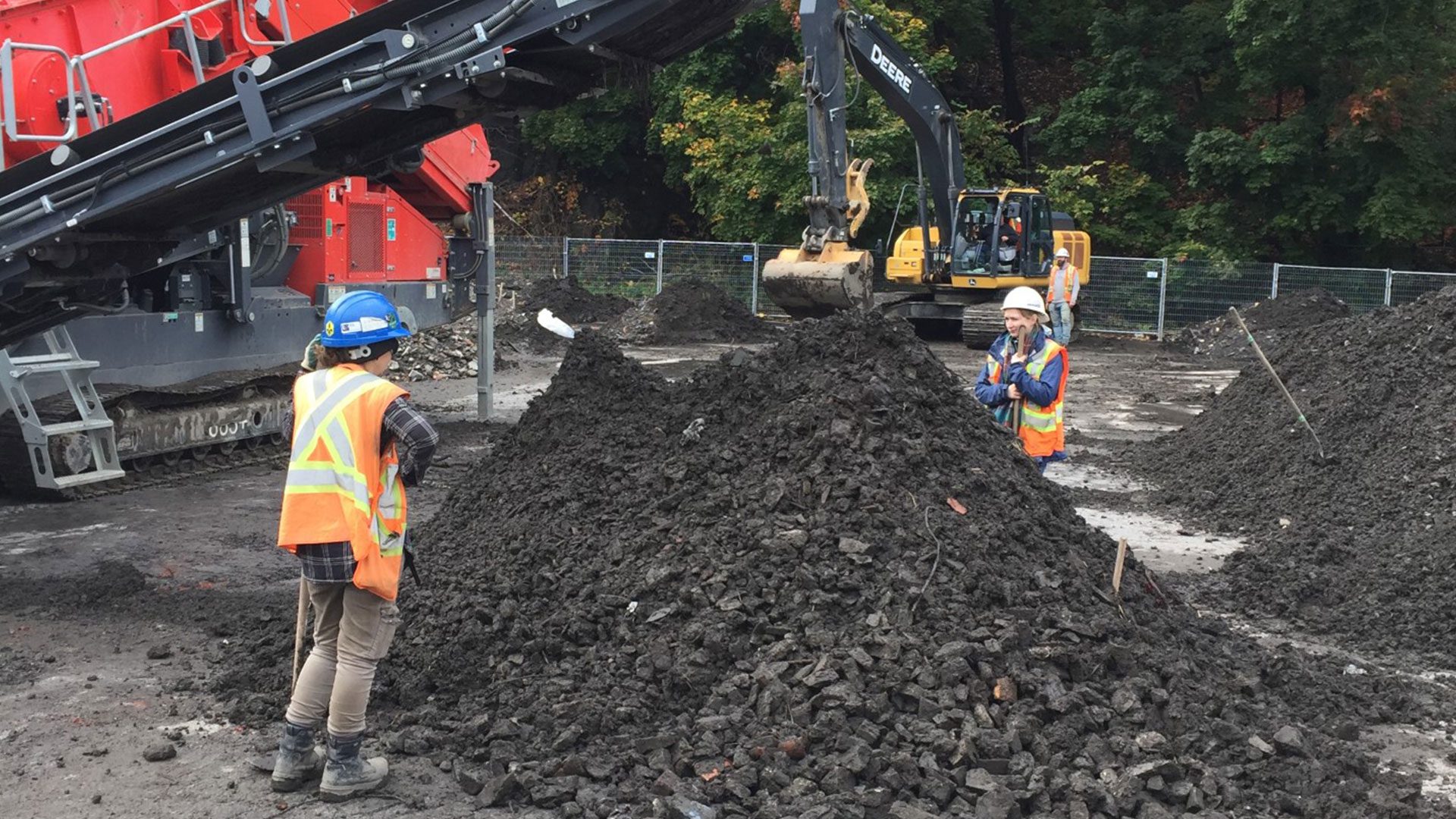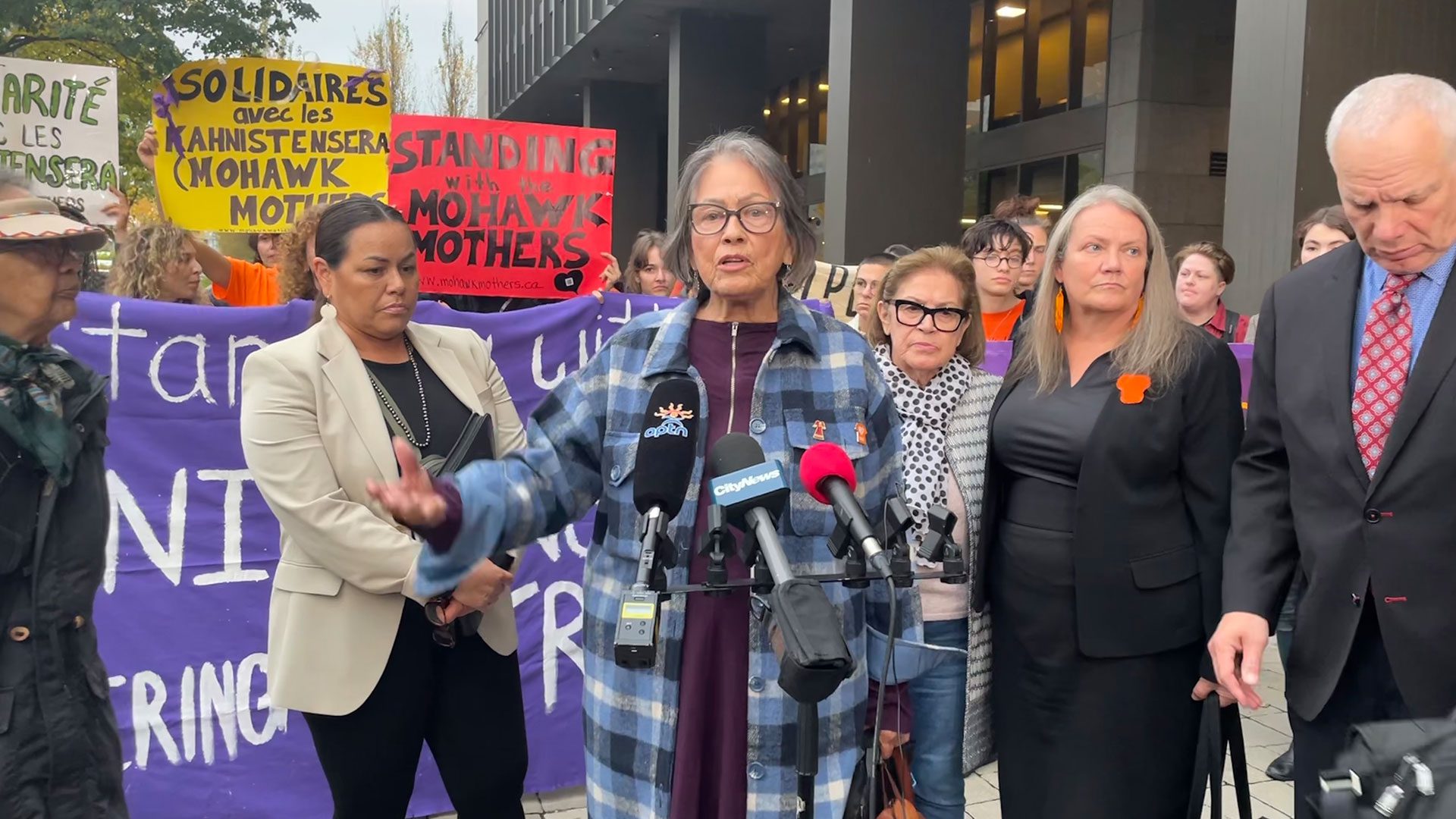An archeologist from Akwesasne Mohawk Territory is questioning the methods being used to excavate an old hospital site by McGill University and Quebec’s public infrastructure society, or SQI.
The site, the old Victoria Hospital, is being excavated and renovated as part of the New Vic Project, a joint venture between McGill and SQI to build a learning hub for McGill’s sustainability systems and public policy programs.
But a group called the Mohawk Mothers alleges that children who were experimented on more than 50 years ago are buried on the site.
Lloyd Benedict, a Mohawk from Akwesasne, has been an archeologist for 20 years and was brought on as a cultural monitor in September. He says he’s never seen archeologists work like this.
To start, he said, mounds of dirt unearthed around the Hersey Pavillion, where historic human remains detection dogs signaled the scent of potential human remains were removed from the site and dumped in a parking lot.
“It takes the context away from everything. Like you’re supposed to be layer by layer by layer, not taking it out in one big clump and putting it in a pile and then digging through there. I mean, they were sifting at first, but then. I just thought it was nothing like I’d ever seen before. I was not very impressed by the way they were handling it,” said Benedict.
Then there’s the sifter the company in charge of the work brought in.
Benedict sent an image of the sifter he took on-site, which appears to be a Finlay 883+ mobile scalping screener, designed for “screening applications such as quarry and mining, iron ore, construction demolition waste, sand, gravel, compost, top soil and coal,” according to the manufacturer’s website.

Benedict said a university would never recommend this machine to budding archeologists.
“Bringing in that auto sifter and just dumping what could possibly be human remains, just dumping it in there and having this thing shake and move,” said Benedict.
Benedict said that after putting it through the auto-sifter, the large rocks were removed and the damp soil had been sifted into a large pile of mud.
“It was just mud on top of mud on top of mud, and we’re kind of looking at each other, and I’m like, ‘You kind of just made it more difficult for yourselves,'” he said.
Rather than passing the dirt through a fine screen, as Benedict said archeologists are supposed to do, they passed through the piles with a rake.
“I was kind of like, ‘Well aren’t you guys supposed to be sifting this, like even though it’s wet you can still put it through the [sifting] screen, and [the Ethnoscop workers said] ‘No, we don’t have to do it this way. I’m sure if there’s anything to find we’ll find it.’ So I’m like all right, well you’re breaking the [settlement] agreement, again, because you already agreed you’re going to sift this stuff.
“I thought it was sloppy, just really sloppy archeology.”
Court orders McGill, SQI to rehire archelogy panel
On Nov. 20, Quebec Superior Court Justice Gregory Moore ordered McGill and the SQI to rehire a panel of expert archeologists to lead the investigation into possible unmarked burials.
“The SQI and McGill must be guided by the panel’s on-going recommendations about how the search for unmarked graves is to be carried out,” said Moore.
The ruling came as a relief said Kahentinetha, one of the Kahnistensera.
“All we did was we used the truth and that’s all, that’s all we have going for us. so of course we were hoping that that’s what was going to stand out in court was what we said, and that’s exactly what happened,” she said.
The archeology panel, made up of Lisa Hodgetts, Adrian Burke and Justine Bourguignon-Thétreault was established in the settlement agreement signed in April between McGill, SQI, and the Kahnistensera. This court-mandated agreement was written to guide the investigation on the site of McGill and SQI’s New Vic project, on grounds owned by SQI partially rented out by McGill.
The archeology panel was mandated to assess and recommend the use of different archeological techniques, to be executed by the archeological firm Ethnoscop, hired by McGill and SQI. But since McGill and SQI dismissed the panel in July, the two institutions have been calling the shots.
A ‘bait-and-switch’

In June, the dogs signaled the scent of human remains at the Hersey Pavillion, which used to be nurses dormitories and ground penetrating radar scans detected several anomalies.
The source of the scent of potential human remains has never been determined, but construction has been underway on this site for months.
The archeology panel’s report submitted July 17, included recommendations to manually search key areas and to allow the panel to analyze the reports from the ground penetrating scans on the site. When the archeologists tried to follow up on their recommendations, McGill and SQI said their mandate was terminated, and declined their recommendation to have the GPR report peer-reviewed.
This prompted the Kahnistensera to take McGill and SQI to court once again on Oct. 27, seeking a halt to the construction in the priority zone and to bring back the panel.
“We just want what we agreed to. We want fairness,” said Kwetiio in front of the courthouse after the proceedings on Oct. 27.
They got support from special interlocutor on unmarked graves Kimberly Murray and her legal representative, Julian Falconer, who said the panel did not get to follow up on archeological findings.
“The minute the panel started making inconvenient recommendations, recommendations that would slow down development, recommendations that would ask serious questions about the results of the cadaver dogs, they were fired,” said Falconer.
Mcgill and SQI drew up the panel’s contract without consulting the Kahnistensera, which stipulated their mandate would be up after filing their July 17 report. Falconer said this maneuver demonstrated a lack of good faith.
“It’s actually referred to in the nomenclature as a bait-and-switch. The good news is, the court wasn’t in any way fooled by it, neither was the Mohawk Mothers,” said Falconer in a Zoom interview on Nov. 24.
The way forward
As of the writing of this report, construction on what is considered the “priority zone” of the project is underway, with no signs of stopping. However, some non-invasive archeological techniques, like a dog search has begun on the rest of the site.
Kahronhianron, a cultural monitor and McGill archeology student, said he’s hopeful the investigation will go better once the archeology panel is reinstated. He said McGill has not communicated to its students that it was found in breach of the settlement agreement.
“To my knowledge, only one email has been sent out so far from Christopher Manfredi, but there really isn’t anything substantial in the email itself. It just says a decision was made and McGill was going to take its time analyzing it to examine the repercussions and next steps, so it was essentially a ‘non-update’ update is how I’d put it,” he said.
Kahentinetha said the Kahnistensera have reached out to McGill and SQI to write a joint letter to the archeology panel to bring them back, but has only received the message that they are studying the judge’s decision.
“I assume that if we write to [the panel] would be in effect, at least I hope that’s what happens. If we don’t get anybody working with us from the respondents, then we don’t know what happens,” said Kahentinetha.









